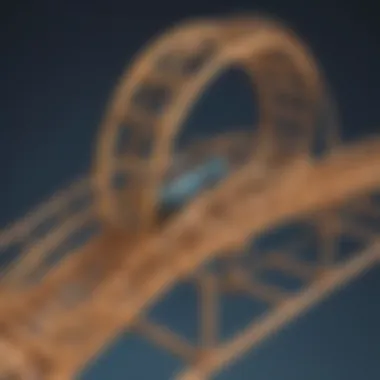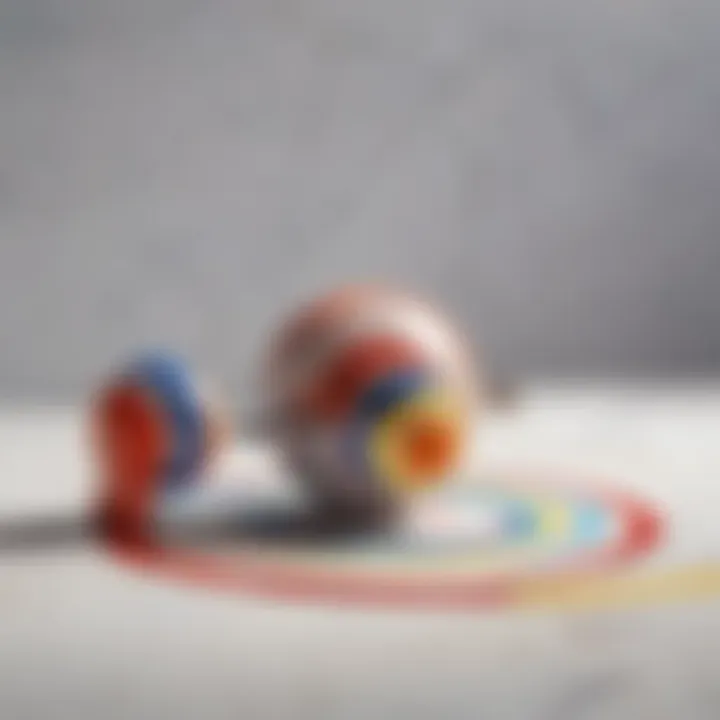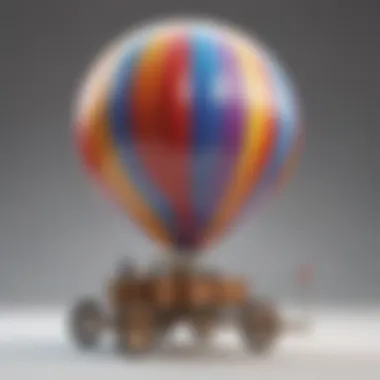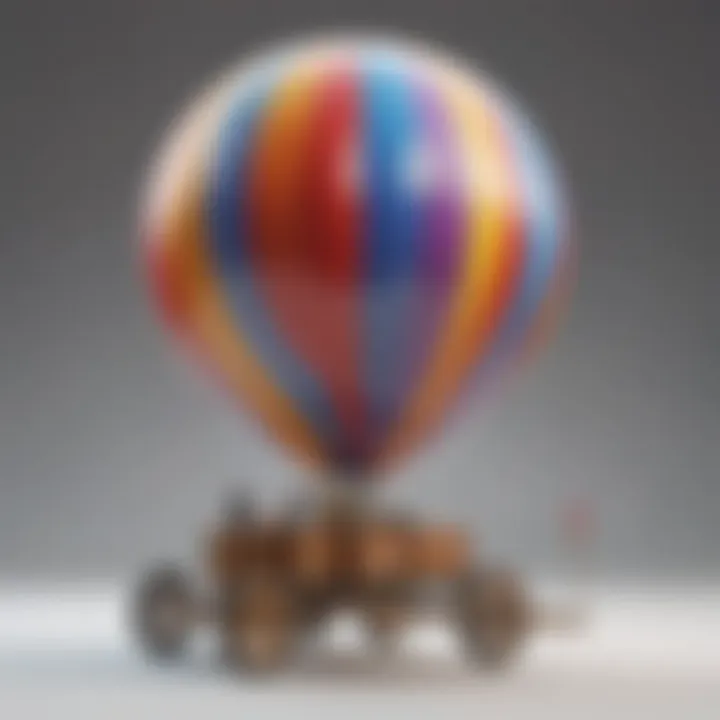Kinetic Energy Experiments to Try at Home


Intro
Kinetic energy is all around us, and understanding it can be a thrilling journey, especially when at home. This guide aims to introduce young learners and their guardians to the fascinating world of kinetic energy through simple yet effective experiments. Imagine transforming your living room into a mini-laboratory where each experiment becomes a stepping stone toward deeper knowledge. This exploration will not only shed light on the principles of kinetic energy but will also spark curiosity and critical thinking, essential skills in today’s world.
Science Fun Facts
Interesting Trivia and Facts
- Did you know that an object in motion tends to stay in motion? That's Newton's First Law of Motion!
- The kinetic energy of an object is proportional to its mass and the square of its velocity. This means that if you double the speed of a toy car, its kinetic energy increases four times!
Quirky Science Stories
Every great scientist was once a curious child. For example, Albert Einstein was fascinated by how things moved, leading him to revolutionize how we understand not just kinetic energy, but the universe itself. It shows that exploring science can lead to amazing discoveries!
Amazing Science Records
- The fastest car in the world, the Bugatti Chiron Super Sport 300+, can reach a speed of 304 miles per hour, showcasing kinetic energy on a thrilling scale!
- Consider the cheetah, the fastest land animal, capable of reaching speeds up to 75 miles per hour within seconds. Their incredible acceleration is a perfect real-life example of kinetic energy.
Thought-Provoking Questions
- Why do you think heavy objects can be just as dangerous as fast-moving ones?
- How does gravity play a role in the kinetic energy of objects?
These questions challenge young minds to think critically about the concepts they encounter in their experiments.
Discover the Wonders of Science
Exploring Various Scientific Concepts
Kinetic energy connects with many aspects of science, including physics, biology, and even environmental studies. Each experiment will peel back layers of understanding, revealing how energy affects daily life.
Educational Videos and Animations
Platforms like YouTube host numerous educational videos featuring kinetic energy concepts. Visual aids help cement understanding, making abstract ideas more tangible.
Interactive Learning Tools
Using apps that simulate kinetic energy scenarios can make learning fun. Experimenting with virtual physics simulations places young learners directly at the heart of scientific principles.
Real-Life Applications of Science
Kinetic energy isn’t just something to learn; it’s everywhere! From the bicycle a kid rides to the cars driving down the road, kinetic energy governs motion in our everyday lives. Understanding this energy helps children make sense of the world.
Science Experiment Showcase
Fun and Engaging Experiments
Here’s where the real fun begins! Below are some accessible experiments that illustrate kinetic energy in ways that children will find engaging.
Step-by-Step Instructions
- Marble Ramp Experiment:
- Balloon Rocket Experiment:
- Gather materials: a marble, a flat surface, and books to create a ramp.
- Set the ramp at an angle using the books.
- Release the marble from the top and observe its speed as it travels down.
- Measure how far it rolls after reaching the bottom.
- Inflate a balloon but don't tie it.
- Tape a straw to the side of the balloon.
- Thread a long piece of string through the straw and stretch it between two points.
- Release the balloon and watch it zoom along the string!
Materials List
You will need items like marbles, balloons, plastic straws, books, and string. Most of these are easy to find in any household!
Safety Tips and Precautions
- Always supervise young learners during experiments.
- Clear the area of hazards before starting.
- Be mindful of sharp objects or breakable materials that can lead to accidents.
Engaging in these experiments not only sparks curiosity but also serves as a hands-on approach to learning about kinetic energy.
By keeping the atmosphere light yet educational, each experiment allows for creativity and inquiry, ensuring a fulfilling science experience at home.
Intro to Kinetic Energy
Kinetic energy is a fundamental concept in physics that plays a crucial role in our understanding of how objects move. As we delve into the various experiments designed to explore this topic, it’s essential to grasp its significance. Kinetic energy isn’t just an abstract theory; it impacts our daily lives, from the simple act of rolling a ball to the complexities of vehicles speeding down the road.
When we observe an object in motion, what we’re seeing is kinetic energy in action. This energy depends on two factors: the mass of the object and its velocity. The formula for kinetic energy is straightforward. To put it simply, Kinetic Energy (KE) = 1/2 mv², where m is mass and v is velocity. Understanding this principle can not only demystify various everyday phenomena but also ignite a spark of curiosity in young minds.
Definition and Importance


To define kinetic energy succinctly, it is the energy an object possesses due to its motion. This is an important aspect to teach children, as it lays the groundwork for understanding more complex physical concepts later on. Kinetic energy is not just a number; it is a part of the universe’s fundamental rules governing motion.
Recognizing the importance of kinetic energy is paramount. It helps children understand that energy isn’t just a distant concept found in science books but something they can see, feel, and experiment with in real life. Engaging in these hands-on experiments aids in grasping the principles at work, fostering both a love for science and critical thinking skills.
The Science Behind Kinetic Energy
Diving into the science behind kinetic energy reveals a rich tapestry of movement and interaction. As already mentioned, kinetic energy is influenced by both mass and velocity. This means that, for instance, a small marble moving fast can have more kinetic energy than a heavy bowling ball rolling slowly. This understanding can lead to various interesting observations and experiments.
The beauty of kinetic energy lies in its relation to other forms of energy. It can transform into other types of energy, like potential energy and thermal energy, illuminating the interconnectedness of various scientific principles. For example, when a ball is lifted to a height, it gains potential energy. Once it’s released and starts to fall, this potential energy converts to kinetic energy. This linking of concepts not only reinforces learning but also contextualizes their application in real-world scenarios.
"Kinetic energy captures the essence of motion and its power to transform and evolve within the fabric of our physical world."
As we embark on this exploration of kinetic energy through various experiments, the understanding of these concepts can drive engagement and inspire future scientific inquiry.
Preparing for Experiments
The excitement of conducting experiments can sometimes blind one to the necessity of preparatory steps. However, having required materials at hand and following safety precautions ensures that participants can fully engage with the scientific principles at play. Not only that, but the process also builds an appreciation for the organization and foresight needed in any scientific endeavor.
Required Materials
Before diving headfirst into the various kinetic energy experiments, it’s important to gather the necessary materials. Having everything on hand will save time and effort later on. Plus, it helps to manage expectations and engage young minds effectively.
Here’s a list of common materials you might need:
- Balls (various sizes and weights): Tennis balls, marbles, or rubber balls can give a clearer insight into kinetic energy.
- Measuring tools: A ruler or measuring tape will help track distances traveled.
- String or yarn: Useful for experiments involving pendulum motion.
- Balloons: Great for experiments associated with propulsion.
- Plastic bottles: Often helpful for making makeshift rockets or gravity-based experiments.
- Scissors: For cutting materials when necessary.
- Sticky tape: To hold different elements together or secure things in place.
Keep in mind that the experiments can often be adapted to use materials you already have lying around the house. This approach not only saves money but also encourages creativity and resourcefulness in problem-solving.
Safety Precautions
Though most of the experiments discussed here may seem harmless, it is crucial to take safety precautions seriously. After all, science should be as safe as it is educational. By mindfully preparing, everyone involved can ensure that the learning experience is both enjoyable and safe. Here’s what to consider:
- Supervision: Always have an adult present, especially when experiments involve physical activities or potential messes.
- Wear safety goggles: Protecting eyes is crucial, particularly in experiments that may involve projectiles or sudden movements.
- Create a safe workspace: Clear away any clutter from the area, ensuring there’s sufficient space for all participants to move around freely without bumping into things.
- Be cautious with materials: Some objects, like scissors or balloons, require a bit of caution. Explain the importance of handling sharp objects carefully and why balloons should be used, especially in the presence of younger children who may put things in their mouths.
- Emergency plan: Be prepared for minor accidents. Know the first aid basics, especially if young learners will be participating.
Taking the time for preparation and safety can turn a simple experiment into an enriching, stress-free learning adventure.
By following these steps, everyone involved can focus on the main event: exploring kinetic energy through hands-on experience. That’s where the real discovery begins.
Experiment One: Rolling Ball Experiment
The Rolling Ball Experiment is a cornerstone in understanding the relationship between kinetic energy and motion. This experiment serves as an excellent introduction to the principles governing kinetic energy, making it suitable for young learners eager to grasp the fundamentals of physics. Not only is it simple and easily executable with everyday materials, but it also resonates with the natural curiosity children have about movement and speed. By observing how a ball moves and interacts with different surfaces, participants can see firsthand how energy is transferred and transformed, opening the door to more complex ideas in the field.
Objective of the Experiment
The primary objective of the Rolling Ball Experiment is to observe how kinetic energy changes as the ball rolls down various slopes. The goal is to demonstrate that the steeper the incline, the faster the ball rolls, translating potential energy into kinetic energy. As a bonus, kids will get to understand concepts like gravity and friction in action as they experiment with different surfaces and angles.
Procedure
- Gather materials: You will need a smooth ball (like a marble or a small rubber ball), a ruler or measuring tape, and different surfaces (like carpet, wood, and tile).
- Set up your ramp by elevating one end using books or a box. The height should be around 30-40 cm for clarity in results.
- Measure the same distance from the base of the ramp (1-2 meters) to where the ball will land, marking it with tape.
- Let the ball roll down from the top of the ramp without pushing it.
- Observe where the ball lands, and record the distance traveled on each surface.
- Repeat the experiment using different surfaces and altitudes, comparing the results to see how they change.
Expected Results and Observations
After completing the Rolling Ball Experiment, participants should notice specific patterns in their results:
- The ball rolls significantly farther on a smooth surface like tile compared to a rough one like carpet, indicating that less energy is lost due to friction.
- As the height of the ramp increases, participants will see the ball rolling faster and landing farther.
- The experience highlights not just kinetic energy principles, but also forces at play, encouraging deeper discussions about why some surfaces are smoother than others and how that relates to kinetic energy.
"Observing these dynamics provides a tangible understanding of how energy works in our world. The Rolling Ball Experiment is a delightful way to explore physics in action."
The insights gained from this experiment will lay a strong foundation for both understanding kinetic energy and fostering a love of science through direct engagement with the material. It’s a prime example of how experimenting can lead to big discoveries, even in a simple context.
Experiment Two: Balloon Rocket Experiment
The Balloon Rocket Experiment is not just merely for fun; it serves as a fantastic gateway into the world of kinetic energy. This experiment contextualizes how potential energy can transform into kinetic energy in a playful and visually stimulating manner. It introduces the concept of propulsion, a fundamental principle that can often feel abstract until demonstrated in such a hands-on way.
The beauty of the balloon rocket is that it requires minimal materials and can be completed in a short time, making it both accessible and attractive for young learners. Caregivers and educators can use this experiment to engage children in discussions about force, motion, and reaction principles. Ultimately, it fosters an atmosphere of inquiry, allowing observers to ask questions and explore the mechanics behind what they see. Remember, learning about science doesn't have to be rigid; it can be lively and dynamic.
Understanding the Mechanics
Before jumping into the experiment, it's vital to grasp the mechanics at play. When you blow up a balloon, you're storing potential energy in the form of compressed air. Once you release the nozzle, this potential energy quickly converts to kinetic energy, pushing air out and propelling the balloon in the opposite direction. This phenomenon is a clear illustration of Newton's Third Law, which states that for every action, there is an equal and opposite reaction.
Here’s a neat breakdown of the key components involved in this experiment:
- Balloon: Stores potential energy.
- String: Acts as a path for the balloon to travel along.
- Tape: Securely holds the balloon in place while maximizing the launched propulsion.
Step-by-Step Instructions
Executing the Balloon Rocket Experiment is straightforward and requires only a few materials. Here’s how you can do it:


- Materials Needed: Gather the following items: a balloon, a long piece of string (about 10-15 feet), a straw, tape, and a pair of scissors.
- Set Up the Launch Track: Tie one end of the string to a chair, doorknob, or any sturdy anchor point. Thread the straw into the middle of the string before securing the other end to another point, making sure it’s taut.
- Prepare the Balloon: Inflate the balloon without tying it. Pinch the end to keep the air from escaping.
- Attach the Balloon to the Straw: Use tape to attach the balloon to the straw. Ensure that it’s aligned so that the end of the balloon points to the back of the straw.
- Launch: Allow the pinched end of the balloon to release and watch as the balloon races along the string track!
Analyzing Results
Once the balloon has completed its journey, it’s time to analyze what’s occurred. Discuss with your young scientists:
- Speed of the Balloon: How quickly did it travel? Was the speed consistent?
- Distance: Measure how far the balloon traveled. Did it go all the way to the other end of the string?
- Force of Ejection: Did they notice variations based on how inflated the balloon was?
By posing open-ended questions like this, caregivers can enhance critical thinking skills and encourage further exploration about kinetic energy.
"Experiments like these highlight the fun in learning while stimulating curiosity and analytical thinking — the cornerstones of scientific exploration."
So, don’t let these observations lie idle. Encourage children to conduct multiple runs with different sized balloons or adjust the length of the string for additional variables to spark even more discussion!
Experiment Three: Pendulum Motion Experiment
This experiment serves as an essential bridge in our understanding of kinetic energy, illustrating the transformation from potential energy to kinetic energy through the graceful arc of a pendulum. Observing this transformation provides young learners with tangible insights into physics, capturing their attention and fueling their curiosity.
Key Concepts of Pendulum Motion
To grasp the pendulum's action, one must first understand a few key concepts:
- Gravity: It's the force pulling the pendulum down towards the Earth. Each swing is influenced by gravity which dictates how fast it moves.
- Potential and Kinetic Energy: When the pendulum is at its highest point, it has maximum potential energy. As it swings down, this pivots into kinetic energy, the energy of motion.
- Oscillation: This term describes the pendulum's back-and-forth movement. It's cyclic, meaning the pendulum keeps swinging unless acted upon.
- Amplitude: It refers to the maximum distance the pendulum swings from its resting position.
These simple concepts not only enlighten the mechanics behind a pendulum but also create a foundation for mixed experiments related to energy. Understanding them is like having a map—it shows where you're going.
Conducting the Experiment
To conduct this experiment, you'll need just a few materials and steps. Here's a straightforward process to follow:
Required Materials:
- A small weight (a washer or a small bag filled with sand works well)
- A length of string or light rope (about one meter)
- A sturdy point to attach your pendulum (like a ceiling hook or a tree branch)
- A protractor or ruler (to measure the angle of swing)
- A stopwatch (to record the time of swings)
Steps:
- Setup: Attach the weight to one end of the string, and secure the other end to the sturdy point, so your weight can swing freely.
- Angle Measurement: Pull the pendulum to one side and use a protractor to measure the angle of the swing; a larger angle means more potential energy.
- Release: Let go of the pendulum and start the stopwatch.
- Timing: Count how many swings it takes for the pendulum to complete a full cycle and measure the time taken.
- Repeat: Change the angle and repeat the timing. Record all your observations.
- Analysis: Take time to compare results across the different angles.
Discussion of Kinetic Energy in Motion
Through observing the pendulum, it’s evident to see kinetic energy in action. Here’s how:
- Transitions of Energy: As the pendulum swings, it continuously shifts between potential energy at its highest point and kinetic energy at its lowest. This visible transformation can intrigue and engage students.
- Energy Conservation: The total energy remains constant, which teaches children about the conservation of energy in a straightforward manner.
- Real-Life Applications: Pendulum mechanics are the backbone of clocks, swings in parks, and even playground seesaws. Relating learning to real-life scenarios cements understanding.
The elegant motion of a pendulum not only captivates the eye but weaves a deeper understanding of kinetic energy.
This experiment beautifully ties theory with practice, leading to discussions about motion, energy conservation, and how science informs the world around us. It's more than just swinging a weight, it's about fostering an appreciation for the dynamics of energy.
Experiment Four: Elastic Potential Energy to Kinetic Energy
Understanding the transformation of elastic potential energy into kinetic energy is an engaging way to see physics in action. This experiment gives students a practical look at how energy can change forms while providing a solid basis for several real-world applications. When kids stretch a rubber band and let it go, they witness the immediate release of energy, which becomes kinetic movement. This concept is foundational in many sports and mechanical devices, making it both relevant and fun.
Conceptual Foundation
Before diving into the experiment, it's crucial to grasp some basic ideas. Elastic potential energy is the energy stored in objects when they are compressed or stretched. Whenever you bend or stretch something, like a rubber band or a spring, you are storing energy within that object. The more you stretch or compress, the more energy accumulates.
Here's a quick overview of relevant concepts:
- Elastic Potential Energy: This refers to the energy stored when objects are deformed. For example, think of a trampoline. When you jump, you compress its surface, storing energy that will bounce you back up.
- Kinetic Energy: This is the energy of motion. When you let go of that stretched rubber band, it snaps back rapidly, converting the stored elastic energy into kinetic energy, making it fly through the air.
- Energy Conversion: Kinetic and potential energy can interchange, as one form of energy transforms into another. This principle is at work in numerous devices, from simple toys to complex machines.
Execution of the Experiment
Materials needed for this experiment are simple and commonly found in most households:
- Rubber bands (various sizes)
- A ruler
- A small toy car (or similar object)
- A flat surface, like a table or floor
Steps to conduct the experiment:
- Measure the stretch: Using the ruler, stretch a rubber band and measure its length. Note this down.
- Secure it: Attach one end of the rubber band to the edge of the table, letting the other end hang free.
- Stretch it further: Pull the free end back by a fair amount—say five centimeters—making sure you’re using a consistent stretch distance for each trial.
- Release and observe: Let go of the rubber band and observe how far the toy car moves as the rubber band snaps back. Measure the distance traveled by the car.
- Repeat: Try this multiple times with different amounts of stretch to see how it affects the distance traveled by the car.
Interpreting Findings
After conducting the experiment, take a moment to analyze the results. Here are some questions to guide your interpretation:
- Distance Traveled: Did the car travel farther with a longer stretch of the rubber band? This could indicate that more elastic potential energy leads to greater kinetic energy.
- Energy Transfer: Discuss how the energy transformation occurs. Does everyone notice the dramatic burst of speed when the band is released?
- Applications: Relate findings back to everyday life. Where can we see similar actions? Perhaps in rubber band-powered toys, or even in nature—like when a bird stretches its wings before flight.


"The world around us is filled with energy transformations—understanding them can lead to fun discoveries and inspire future scientists!"
Experiment Five: Marble Drop Experiment
The Marble Drop Experiment is a fascinating way to explore the principles of kinetic energy. This experiment is essential in this article as it illustrates the conversion of potential energy into kinetic energy through a simple yet effective setup. Engaging in this activity helps demonstrate how height influences the speed of an object. This experiment particularly appeals to young learners because it relies on easily obtainable materials, making science accessible and fun at home.
Theoretical Background
Understanding the Marble Drop Experiment begins with a solid grasp of concepts such as potential energy, kinetic energy, and the laws of gravity. When a marble is held at a certain height, it possesses potential energy due to its position. This energy is directly proportional to the height from which it will be dropped. When released, the marble accelerates downward due to gravity, converting that potential energy into kinetic energy – the energy of motion.
The relationship between potential energy (PE) and kinetic energy (KE) can be expressed with the formulas:
- Potential Energy (PE) = mass (m) × gravity (g) × height (h)
- Kinetic Energy (KE) = 1/2 × mass (m) × velocity (v)²
This means that the higher you drop the marble from, the more potential energy it will have to turn into kinetic energy as it accelerates towards the ground. The beauty of this experiment lies in its ability to visualize these theoretical concepts in action.
Experimental Procedure
Conducting the Marble Drop Experiment is straightforward, requiring minimal materials:
- Gather a marble, a ruler or measuring tape, and a stopwatch (if available).
- Measure a height of about 1 meter (or any chosen height) using the ruler or measuring tape. If you're aiming for different heights, mark various points.
- Begin the Experiment: Drop the marble from the marked height and use the stopwatch to measure how long it takes to hit the ground. If you do not have a stopwatch, having an observer to count down and shout when the marble impacts the ground can work too.
- Repeat the process for different heights, say 0.5 meters, 1 meter, and 1.5 meters. Each time, make sure to record the time it takes for the marble to reach the floor.
- Discuss the observations right after, asking questions like, "What happened as the height increased?" or "How did the marble’s speed change?"
Results and Analysis
After dropping the marble from various heights, the results collected will demonstrate a correlation between the height of the drop and the time taken to reach the ground. You might find that the marble dropped from the highest point took significantly less time to reach the ground compared to the lower drops.
To analyze the relationship further, you can calculate the expected kinetic energy using the corresponding height. Analyzing the measurements helps show that with greater potential energy comes increased kinetic energy upon impact, aligning with the theoretical framework.
This experiment not only sheds light on kinetic energy but also opens discussions on air resistance, friction, and practical applications in physics.
"Experimenting with everyday scenarios turns abstract science into tangible knowledge. Embrace the curiosity!"
This Marble Drop Experiment encourages continuous learning and inquiry about energy in motion, solidifying the understanding of kinetic energy in fun and relatable ways.
Connecting Kinetic Energy to Everyday Life
Understanding kinetic energy isn’t just a classroom endeavor; it resonates profoundly within our daily routines and surroundings. By making this connection, we can see that the principles of physics are woven into the fabric of our normal existence. Every action, from a child running across a playground to the familiar hum of a vehicle on the road, embodies kinetic energy in motion. This section invites readers to appreciate how relevant kinetic energy is to life, sparking curiosity and potentially paving the way for deeper scientific exploration.
Examples in Daily Activities
Here are some vivid instances proving how kinetic energy takes center stage in our everyday lives:
- Riding a Bicycle: When one rides a bike, kinetic energy is generated as the legs push the pedals. The speed of the bike increases with the strength of the rider’s strokes. It’s fascinating to note how energy transforms and is influenced by motion.
- Sports Activities: Think of a soccer ball soaring through the air after a powerful kick. The energy imparted by the player translates into kinetic energy, allowing the ball to travel at high speeds. It’s this very energy that can cause a goal celebration or a heart-stopping near miss.
- Walking or Running: As people walk or jog, they are constantly shifting their mass forward. Each step translates body weight into kinetic energy. The faster one moves, the more kinetic energy is involved. All shapes and sizes of activities play a role here.
- Drop a Object: When someone drops a pencil from a table, it accelerates due to gravity, accumulating kinetic energy as it falls. This simple act is an everyday reminder of how kinetic energy works in different scenarios.
- Vehicles in Motion: Every time you see cars driving down the street, they are full of kinetic energy. The faster these vehicles go, the more kinetic energy they possess. It’s critical to remember how this energy can be harnessed for constructive purposes, like transportation, but also needs to be handled with caution.
By observing these examples, young learners can start recognizing the science behind the movements they see. Real-life applications of kinetic energy not only breathe life into the subject but also encourage inquisitive minds to ask questions, fostering an environment ripe for discovery.
Observations and Reflections
After actively noticing kinetic energy in their surroundings, participants should take a moment to reflect on their findings. Several questions may arise from their observations:
- How does speed influence the amount of kinetic energy? When riding a bicycle faster, does one notice the wind's effect? More speed means more energy!
- In different sports, which actions generate the highest kinetic energy? For example, what about the energy in a basketball when it bounces? The force applied changes the outcome.
- How do we ensure safety around moving objects like cars or bicycles? Recognizing the potential danger can lead to more cautious behavior.
Evaluating these experiences helps cement the concepts of kinetic energy in practical terms. Participation in such reflections not only enhances understanding but also builds critical thinking skills that can be applied academically and personally. It shifts the focus from theoretical knowledge to practical insights.
"Kinetic energy is all around us; observing it helps us understand the world more deeply."
In summary, connecting kinetic energy to everyday life serves up a great opportunity. It unravels the scientific principles in relatable terms and fosters a thirst for knowledge. This connection is pivotal, as it can inspire the next generation of scientists, thinkers, and innovators.
Closure and Further Exploration
As our exploration of kinetic energy experiments winds down, it’s crucial to reflect on the significance of engaging with these concepts beyond the confines of our experiments. Each activity we undertook in this article was not only a means to demonstrate kinetic energy but also an entry point into the wider world of physics and science. Through observation and participation, young learners discover that these principles are not trapped in textbooks—they reverberate through the everyday wonders around us.
Kinetic energy isn't just found in the laboratory; it exists in the playground, on the basketball court, and even in the simple push of a swing. Understanding how energy transforms and behaves helps children appreciate their environment in new ways. They learn to recognize energy in motion, which can ignite curiosity about how different forces work together in harmony. This foundational insight can be a springboard for further investigation in physics and other scientific fields, planting the seeds for future scientific endeavors.
"Science is not only a disciple of reason but, also, one of romance and passion." - Stephen Hawking
By participating in these experiments, students engage more than just their hands; they engage their brains. Resilience is built during trials that don’t go as planned, observations encourage critical thinking, and discussions with guardians enhance understanding. With these simple, hands-on experiments, the journey of scientific discovery is sparked, encouraging a lifelong love for learning and exploration.
Summary of Findings
In summary, our journey through the kinetic energy experiments revealed the following key points:
- Definition of Kinetic Energy: Kinetic energy is associated with objects in motion. As speed increases, so does this energy, highlighting the nature of movement itself.
- Practical Applications: Each experiment brought the abstract concepts of energy into tangible activities, allowing participants to see the principles in action.
- Critical Thinking Development: Engaging with these experiments built observational and analytical skills, which are vital for scientific inquiry.
- Safety First: Emphasizing safety at every step ensured that these experiments could be conducted easily and without worry, promoting a comfortable learning environment.
This grasp of kinetic energy isn't a mere academic exercise. It forms a broader understanding of various phenomena that interact in our daily lives, from riding a bicycle to understanding sports motions.
Encouraging Continued Learning
Continuing the quest for knowledge is vital in nurturing inquisitive minds. Here are some ways to keep the momentum going:
- Explore More Experiments: Delve into experiments that involve potential energy, thermal energy, or electrical energy. Each type offers unique insights and understanding of how energy manifests in different forms.
- Visit Science Museums or Planetariums: These venues provide interactive experiences that make learning about kinetic energy and beyond exciting and engaging. Look for demonstrations focusing on physics or engineering.
- Read Books Together: Peruse literature that discusses not only kinetic energy but other branches of science. Authors who write science fiction or non-fiction can ignite imaginations.
- Join Science Clubs: Many local schools or community programs offer clubs that engage children with hands-on activities, discussions about discoveries, and opportunities to showcase knowledge at science fairs.
By coaxing curiosity and encouraging practical experiences, guardians can play a pivotal role in fueling a passion for learning. Science, in its essence, is the joy of discovery, and fostering this joy helps develop future thinkers and innovators.







